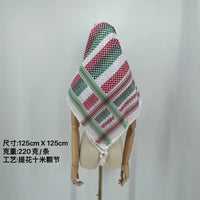In today's globalized world, cultural symbols and attire have become more common in workplaces. One such item is the keffiyeh, a traditional Middle Eastern scarf that carries deep cultural and political significance. But is it okay to wear a keffiyeh to work? This article delves into the nuances of wearing a keffiyeh in professional settings, exploring cultural sensitivity, potential repercussions, and tips for navigating workplace policies.
Understanding the Keffiyeh
The keffiyeh, also known as a kufiya, is a traditional square scarf worn in the Middle East. It is often associated with Palestinian culture and has become a symbol of resistance and solidarity. While it serves practical purposes, such as protection from the sun and dust, it also holds deep cultural and political meanings.
Cultural Significance
Wearing a keffiyeh is more than a fashion statement; it is an expression of cultural identity and solidarity with the Palestinian cause. Understanding its significance is crucial before deciding to wear it in any setting, especially at work.
Is It Okay to Wear a Keffiyeh to Work?
Assessing Workplace Culture
Before wearing a keffiyeh to work, it's essential to assess your workplace culture. Some workplaces may embrace diversity and cultural expressions, while others might have strict dress codes or policies regarding political symbols. Here are a few steps to consider:
- Review Dress Code Policies: Check your company's dress code policies. Some organizations explicitly prohibit political symbols or attire that may be deemed controversial.
- Gauge Workplace Environment: Observe how open your workplace is to cultural diversity. Are colleagues supportive of cultural expressions, or is there a history of pushback?
- Seek Guidance: If unsure, seek guidance from HR or a supervisor. They can provide clarity on what is acceptable and help you navigate potential issues.

Potential Repercussions
Wearing a keffiyeh to work can have varying repercussions depending on the workplace environment. Here are some possible outcomes:
- Support and Solidarity: In inclusive workplaces, wearing a keffiyeh might be met with support and curiosity. It can be an opportunity to educate colleagues about its cultural significance.
- Misunderstanding and Pushback: In less inclusive environments, wearing a keffiyeh might lead to misunderstandings or accusations of pushing a political agenda. This could result in disciplinary actions or strained workplace relationships.
Handling Pushback
If you face pushback for wearing a keffiyeh at work, consider these responses:
- Educate and Inform: Politely educate colleagues and supervisors about the cultural significance of the keffiyeh. Emphasize that it is a symbol of cultural identity and solidarity, not a political statement.
- Seek Allies: Find colleagues who support cultural diversity and can vouch for your intentions. Having allies can strengthen your position and foster a more inclusive environment.
- Know Your Rights: Familiarize yourself with workplace discrimination laws. If you believe you are being unfairly targeted, seek legal advice to understand your rights and options.
Ethical Considerations
Cultural Appropriation vs. Solidarity
For non-Arabs considering wearing a keffiyeh, it's essential to distinguish between cultural appropriation and solidarity. Wearing a keffiyeh without understanding its significance can be seen as cultural appropriation. To avoid this, educate yourself about its history and meaning, and wear it as a gesture of solidarity and respect.
Ethical Implications
Consider the ethical implications of wearing a keffiyeh in your specific role. For example, as a barista, wearing a keffiyeh might be less controversial than in a corporate setting where dress codes are stricter. Always weigh the potential impact on your professional relationships and responsibilities.

Conclusion
Wearing a keffiyeh to work is a personal decision that requires careful consideration of workplace culture, potential repercussions, and ethical implications. By understanding its cultural significance and navigating workplace policies thoughtfully, you can make an informed choice that respects both your identity and professional environment.
In conclusion, it's essential to foster open dialogues about cultural expressions in the workplace. Encouraging diversity and inclusivity benefits everyone, creating a richer and more understanding work environment. If you choose to wear a keffiyeh, do so with pride and respect, and be prepared to educate and engage with your colleagues about its significance.





